Global Central Bank US Treasury Debt Reserves & So Much Money, So Little Metal
The US dollar is becoming less attractive to central banks as a reserve asset. From July 2010 to July 2011, central banks as a group have reduced their holdings of US Treasury Debt by $352.7 billion (-7.88%), as the Fed increased their holding of US Treasury debt by $590 billion (+28.63%). These are amazing sums when we realize how large the* TOTAL * US national debt was in August 1971. The US national debt was $460 when the US Treasury closed its gold window. In the last twelve months, the Federal Reserve monetized more US Treasury debt than existed forty years ago.
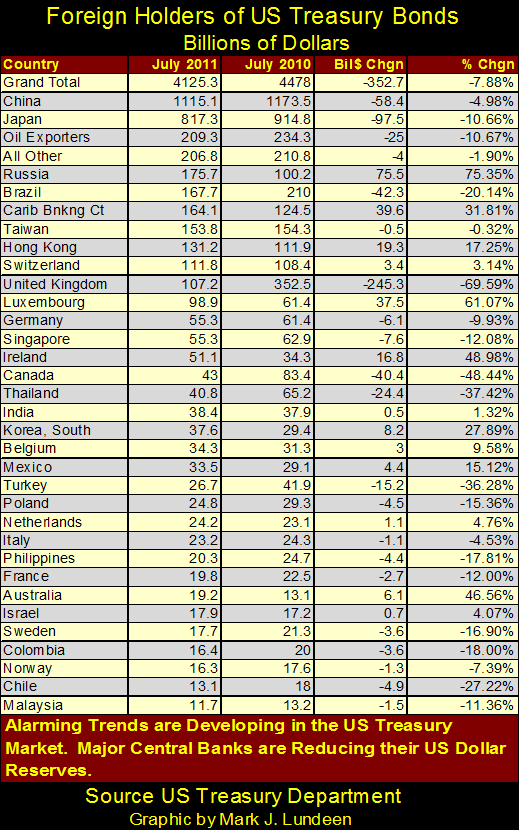
When we consider what the Federal Reserve, with the full support of Washington's political class, is doing to the currency that the US Treasury debt's interest and principle are paid back in, one really can't blame T-Debt holders, both foreign and domestic, for buyer's remorse. This is especially true when the Obama Administration feels it has no other choice but use its Justice Department as a tool to defend its Treasury's AAA rating.
Only a dull blade would fail to understand that for decades, the debt-backed US dollar's primary purpose has been to make good Wall Street's gambling debts, and to fund Washington's failed experiments in social engineering. This expansion of currency was not done for the benefit of successful commerce and profitable labor. The Federal Reserve's inflationary dollar provided funding for bizarre Federal programs, such as providing high powered guns to Mexican drug cartels, funding solar power companies, and electric cars for markets that will most likely never exist. The Federal Reserve has been the government's mechanism that enabled spendthrift politicians, bankers and academics to squander the world's wealth for decades.
Money backed, and convertible into gold, would never have allowed the creation of huge bureaucracies that have never performed as promised. The Department of Energy was created during the Carter Administration to make the United States energy independent. Carter also created the Department of Education. Both these huge bureaucracies have failed in their stated missions, both continue to receive increases in funding, thanks to inflation, to do everything BUT make the US energy independent and better educated. But the "policy makers" don't care, as these bureaucracies serve their creators' purposes, if not the public's. Both are funded with US Treasury debt, which the Fed can then monetize, and recycle the "liquidity" back to Washington and Wall Street. I dread the coming day when nationalized healthcare is imposed on the United States, but you can be sure that many in Washington can't wait!
Look at the chart below; what in the hell has the US Treasury and the Federal Reserve been doing with the US dollar since 2007? Should we be surprised that today, central banks are distancing themselves from AAA-rated US Treasury debt? The Justice Department shouldn't be investigating Standard and Poors for downgrading the Treasury's debt, but Moody's and Fitch for maintaining it!
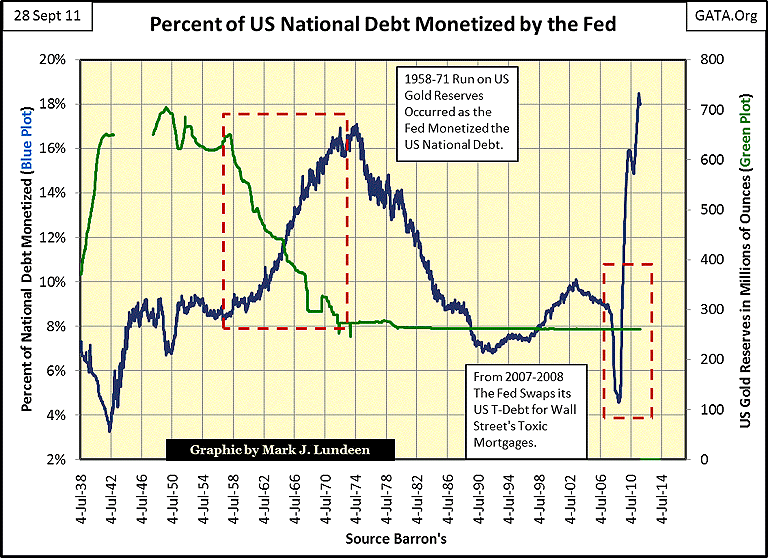
Charts like the one above are never shown to the tax-paying public, or the tuition-paying college students sitting in Doctor Bernanke's old class room. However, we can be sure that since QE1, central banks and hedge-fund managers who have taken a shine to gold and silver follow every twist and turn of the plot above. Why would that be? Because they know that what the Federal Reserve does to its balance sheet * DOES * matter to the current valuation of the US dollar, as well as to the future price of gold and silver. It's no coincidence that in 1958, central banks began a run on the US gold reserves as soon as it became apparent that the Fed was intent on monetizing more than 9% of the US national debt.
CNBC believes they can ignore the decaying financial situation of the US Treasury. But foreign central banks, with tens & hundreds of billions of US debt standing in for their monetary reserves, know they cannot. If they can no longer exchange their unwanted US dollars for gold stored at the US Treasury's gold window at $35 an ounce, they are more than willing to exchange their dollars in the open market, at prices over $1600 an ounce. Their problem is that they want to buy gold by the ton, but tons of gold are rarely available in the open market.
That few private citizens have yet to trade their dollars for $1600 gold, and $30 silver is largely a function of their education by academics, like Doctor Bernanke. So, seeing gold and silver demonized by the financial journalists is no surprise to me. The failure of financial journalists to understand the inflationary implications of the chart above, and below, is astounding, yet predictable. For decades, Keynesian economic theory, which justifies an ever expanding national debt has been taught to millions of college students at prestigious educational institutions. "Big Education" knows very well the benefits it receives from supporting the debt backed dollar:
- Government guaranteed school loans for students
- Government grants for dubious social and economic research
- Positions of great influence in an ever expanding Federal government bureaucracy
To "academics", the plots on the chart below are only three more reasons for increased government funding of "monetary policy" research. It's a sad fact to note, but the fate of the world's money is in the hands of charlatans, swindlers and quacks.
Whatever the reason, ignorance is never an excuse in the eyes of the law, but it will do just fine on television when the US Treasury market begins to deflate, as all inflationary bubbles eventually must. When US Treasury yields begin to rocket upwards, global flight capital will panic into gold and silver. This event will come as a total surprise to people on both sides of the nation's TV cameras, as both sides are totally ignorant of the history of fiat money. Paper, and now digital money, always become worthless for reasons VERY apparent in the charts above: absent gold, there is no check on monetary inflation when the volume of money in circulation is determined by an elite few. Eventually, all fiat monetary systems begin to inflate towards infinity, resulting in its unit of trade becoming worthless.
What are the potential gains for investors in gold and silver, as well as mining shares? It's impossible to say. Over the past years, I've said that $30,000 gold was a sure thing before the gold bull market is over. But that was before Doctor Bernanke began his quantitative easing #1 & #2, a time before the Green CinC plot above fell below the digital dollars plots in the chart above.
In March 2008, I penned a piece titled Bernanke, Inflation and Prices. This article had nothing to do with prices, but looked at the growth in US Currency in Circulation (CinC) and production of basic materials since 1960. 1960 is a good starting point, but older data is better. As my source for the basic materials is the US Geological Survey, which actually had data going back to 1900, why not start before 1960? As I have CinC data going back to 1919, I used 1919 as my starting point. By the way, the cement data starts in 1926. I included it with the metals as cement is one thing that every growing economy uses in great quantity.
Note: all production data in the table is global, not US. But as the US dollar is currently the world's reserve currency, this seems appropriate. We should also understand that in 1919, the world still believed that gold was money, and paper money was a debt payable in gold. Yes, World War One changed all that, but paper money in 1919 had yet to usurp gold's place in the money supply in the minds of officials and the public, if not the in the mind of the Creature from Jekyll Island.
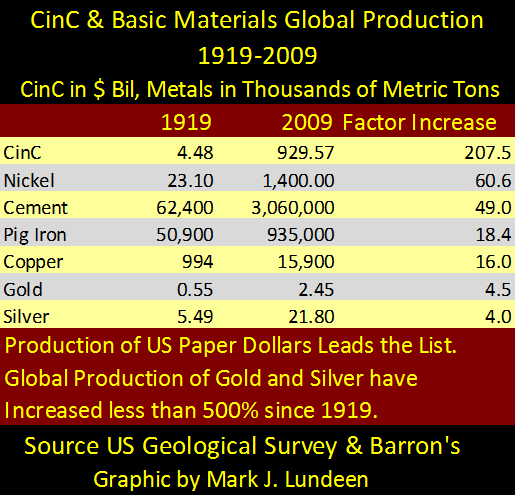
Money functions as a catalyst, and as all catalysts do, facilitates desirable reactions without itself being consumed. So, all the paper dollars created since 1919 are still circulating in the economy. Sure, the banking system removes worn bills from circulation, but they are replaced with new notes. CinC below, unlike the other items in the table, lists the total number of paper dollars then in circulation, not the annual increase in paper dollars Washington "injected" into the economy that year.
The other items in the table above, unlike CinC, lists annual production for only two years: 1919 & 2009, not the sum-totals of 90 years of annual production. So am I comparing apples with oranges with the table above? As for methodology; yes, but practicality; no. Money always circulates from one transaction to another, and is never destroyed in the process. No merchant receives a $100 bill received in payment, and then discards it with yesterday's leftovers. How cement, iron or copper flow through the economy is different than does money. Though recyclable, they are typically used in ways that removes them from the market place. Walking down any city street, we pass many tons of cement, steel and copper used in construction many years ago. But if a contractor wants cement and copper for new construction, most of his supply will, by necessity, come from new annual production listed by the USGS in the table above, not the Golden Gate Bridge. But money is different; money used to fund the Golden Gate Bridge is still circulating in the markets, as seen in the Fed's balance sheet above.
Gold on the other hand, is different. Gold is either hoarded as a store of wealth, or used as jewelry, but it isn't fabricated into consumer goods with a limited-service life. So like CinC (money), we can add up the production of gold for every year since 1919, and come up with a back-of-the-envelope sum-total of the stock of gold currently available, which I've placed in the table below. Yes, I'm ignoring the gold mined in South America by the Spanish hundreds of years ago, as did my source for all my data in these tables: the US Geological Survey. Maybe if the government sent a few million research dollars my way, I could be a little more precise in my figures.
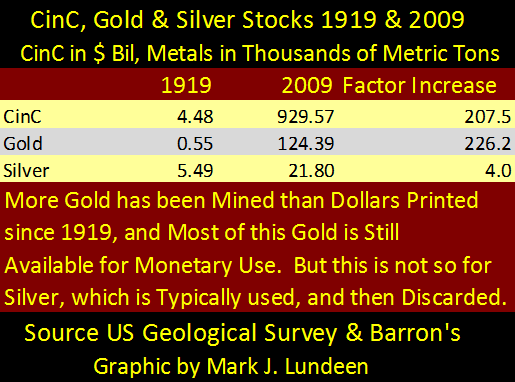
All the gold in the world is available to be monetized, should its owners decide to convert their Jewelry into money (gold coins). And as seen above, the amount of gold available to be monetized has actually exceeded the number of paper dollars issued since 1919. So, there is no practical reason we could not return to the pre-WW1 gold standard, other than usual suspects' current economic inflationary system would not survive honest money.
David Fischer's: The Great Wave book covers a period of time during Europe's high-medieval era (1100-1300) where international trade began booming, but most of Europe's gold was locked up as personal jewelry or used in churches for ceremonial purposes. Gold became so valuable, in terms of goods and services available to the limited gold coins then in circulation, that churches and nobles soon chose to have their decorative gold melted down, and minted into gold coins. Today, all of the world's wealth is currently defined in terms of paper assets that are quickly wasting away. At some point, social pressures will likely once again force the paper-money guild to make way for real money.
But silver in the table above lists its annual production for 2009, not its 90 year sum total, as I used for gold. This is because silver, unlike gold, IS consumed, but unlike iron and copper, it is un-recycled and lost.
In the 20th century, the US Treasury once had many billions of ounces of silver bullion stored in its vaults. This was true for many countries, just as it is also true that today, no country's treasury holds silver in storage as a reserve asset. In the decades following the removal of silver from US coinage in 1965, most of the silver held by foreign governments was sold off at prices less than $5 an ounce. So in the table above, I chose to use the annual production of silver, for the silver available for investment purposes. I know the actual figure is significantly higher than this, but we must recognize that before the 20th century, before silver became prized for its indispensible chemical properties by industry, silver * WAS * horded as money, as gold still is. In 1900, the first year the USGS has data for, there was 15 to 20 times as much silver, as gold, available in the market place; however this is no longer the case. There is good reason to believe that today, there are more tons of refined gold than silver. As industrial demand for silver isn't going away, increasing investment demand for silver makes the tiny silver market potentially explosive.
The Silver to Gold Ratio (SGR) is once again over 50, but I don't expect it will stay there for long. In December 1979, this ratio bottomed at 15.5 ounces of silver for one ounce of gold. But in 1979, there was more refined silver in the world than gold. This is not so in 2011! Given the demands of industry, and rising investment demand for silver, I expect the SGR ratio's old lows of 1979 to be taken out decisively in the coming years.
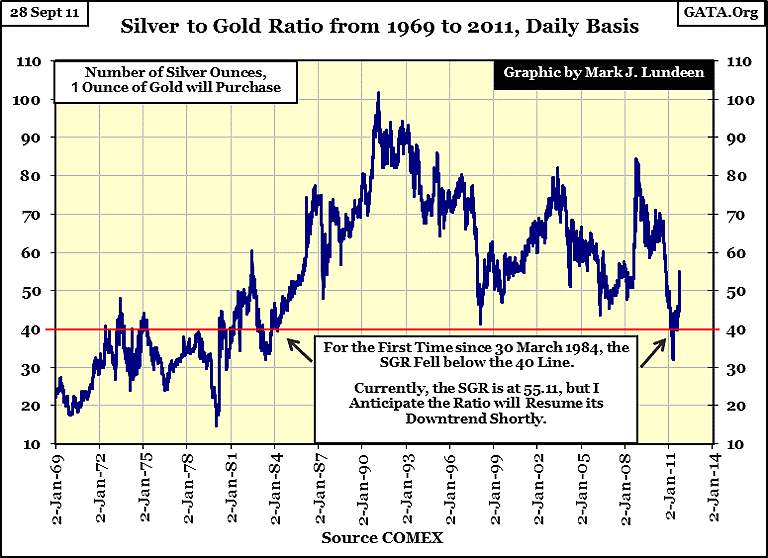
Next are two chart using the annual global production data from the USGS. Remember, the data for the metals (and cement) are yearly global production figures, while CinC is just that, the number of dollars available to purchase goods and services, as well as the * available * pig iron and copper tubing, which is only a small percentage of the actual global production of the past 90 years. If market prices are going up, we should not wonder why, or should we expect * long-term * rising price trends to reverse themselves, until prices of goods and services are once again fixed in a stable monetary unit of trade.
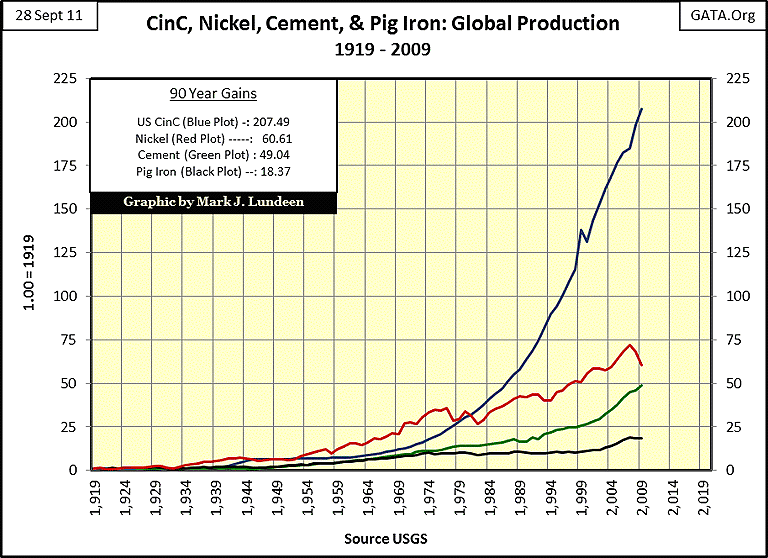
I look at these charts, and can't help thinking how many dollars there are, and how little metal there is in the world. The potential for making huge profits from investing in precious and base metal mining is tremendous!
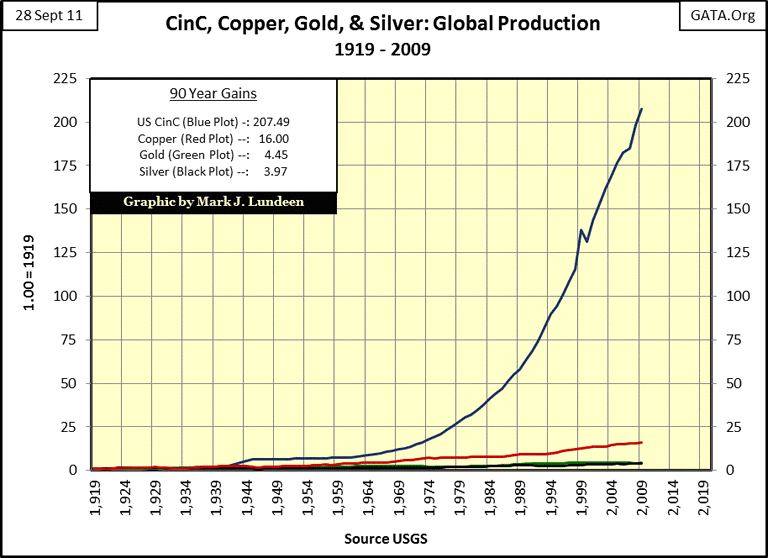
Copper, and other base may become the unspoken saviors of industry. CNBC makes much of the trillions of dollars the S&P companies have in "cash." Well, today's cash, is going to be tomorrow's trash, because the world's monetary authorities are locked into an inflationary/debt spiral that will end in disaster to those who hold their "money" to dear. Someone, somewhere in the world who controls a large industrial concern, is going to figure out that copper is a superior store of value than "cash", as copper is also an inflationary hedge in a hyper-inflating economy. Big-heavy ingots of copper, and other base metals would be safer to store on premises than equivalent dollar values of gold or silver. Just a thought.
[email protected]
















